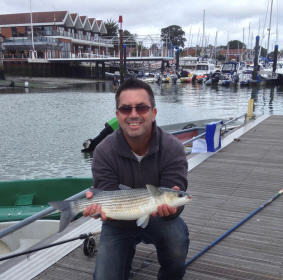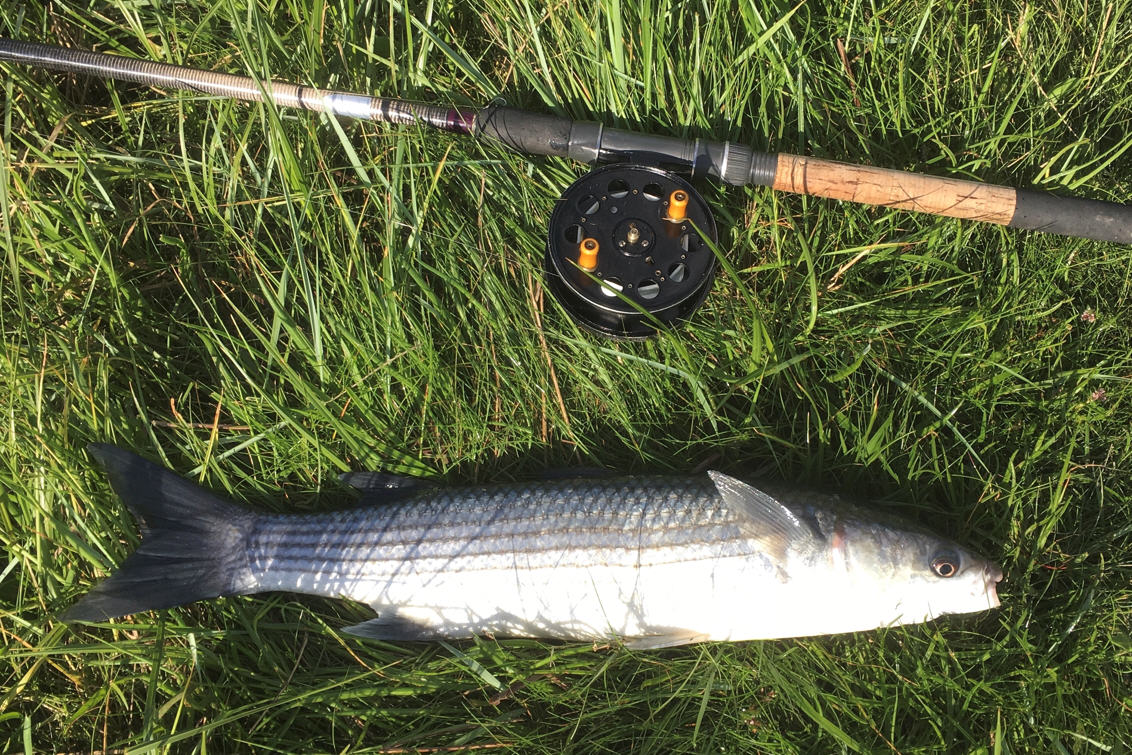|
Home Long Trotting |
Trotting and Feeding
|

|
|
Mark brings freshwater fishing methods to mullet angling. His methodical approach to float fishing and feeding illustrates how skills learned in other fields can be successfully employed on mullet.
I started coarse fishing when I was about 9 years old and progressed to match fishing. In about 1995, I went sea fishing with my brother Alan and enjoyed it so much that within about a year, I was only going sea fishing. We decided we needed to improve our casting and went to have lessons with Paul Frid. Paul was involved with the National Mullet Club; we all became good friends and Paul helped me catch my first mullet, on the Hamble. The mullet I fish for on the River Adur have similar feeding habits to the wary chub I used to catch on the Thames, which have been caught or fished for on numerous occasions. Trotting and feeding for these fish in medium to fast flows has taught me float control, mending the line (keeping a tight line to the float) and feeding techniques which have proved effective in catching mullet. I have found that in most of the swims I fish on the lower Adur, the best area for catching mullet is from the very edge of the swim, to about one and half rod lengths out. This is where most mullet patrol on the edge of the flow or a feature that disrupts the flow. All the swims I fish have some form of feature, be it small bays that create an eddy, bends with deep water only a few inches out, or pipes and bridges. I have caught fish in less than one foot of water trotting no more than six inches out against mud banks. For most of my trotting, I use a bodied wire-stemmed stick float carrying 3 - 5 BB; straight bodies for calm / flat swims and round chubbier bodies for windy / boiling swims. For most swims up to 3 feet deep, I have found a single No 8 shot, 8 inches from the hook with the bulk under the float simple and effective. Over this depth I would add another No.8, half-way between the float and the other dropper shot; when holding back the float, this allows the bait to rise and fall more naturally. When a suitable swim is found, I study it for fish movement and a good line for trotting. Moving a few feet up and down a swim can make a difference to the distance out your float trots (so always have a few trial runs in new swims to find a good line to fish). If no fish movement is seen, I initially feed the swim, with 3 apple-size handfuls of liquidised bread. One ball needs to go where your float will start its trot, one about a metre downstream, and the last one a metre downstream from that. This should start to draw fish into the swim. From then on you need to feed every cast (about a walnut-sized ball of ground bait). When you cast, you need to mend the line to the float and then put a small ball of ground bait as close to the float as possible, every so often putting small balls of feed in the swim further down. You must feed every cast as your ground bait is soon washed away; just feed smaller balls once you have fish in your swim. If I am holding back or slowing the float down during a trot, I will sometimes double-feed a cast; feed as you start your trot, then feed again straight in front of you as the float reaches half way through the swim. Then as you hold back or slow the float down, this groundbait slowly catches up with your float. You only use small balls of groundbait, half the amount of a normal cast, but you feed twice; this can really get a shoal of mullet in a feeding frenzy. Once you have fish in your swim, always carry on feeding to give the fish a focal point, hopefully with your hook bait in amongst it. If there is an eddy in the swim, it can be effective to hold the float back hard towards the end of your trot, allowing the float to pull towards the bank. The float should then start to move towards you slowly; just make sure you wind in the slack line carefully to keep in contact with the float, but not to alter its presentation. If no fish movement is seen, or no bites occur, I always feed some more ground bait further downstream to try and entice fish to move up. If I have no bites or do not see any fish after an hour in a new swim, I will fish it at different states of the tide until I dismiss it as no good. An example of how these feeding methods can work occurred when I took my friend Peter fishing; we were about 40yrds apart, both using identical gear, rods, reels, floats, even down to the depth we were fishing. I started by putting 3 balls of ground bait spread down the swim, and because there was a nice steady flow, I was slowing the float down and holding back on most trots. Because of this, I was double feeding on every cast, and after about 10 minutes I saw a fish swirl downstream. I cut the ground bait down to once a cast, and a couple of trots later the float shot under. After a good scrap, a mullet just over 3lbs was in the net. I carried on feeding in the same way and about 15 minutes later I hooked another fish, which put up a good fight and weighed just under 4lbs. Pete came up and asked what he was doing wrong, as he had not had a bite, so I went to his swim and watched him fish for a few minutes. The only major difference was in the amounts and timing of our groundbaiting. After 5 minutes of showing Pete how I was feeding I left him to it; the only encouragement I gave him after that was to shout 'feed ' every time he forgot (which I found amusing but I do not think he did!). After about fifteen minutes he shouted he had a fish on. It put up a terrific fight, and after ten minutes Pete landed a 4lb 12oz mullet. I was just as happy as he was. This is a very busy fishing technique, and I find a bait smock invaluable, allowing you to stand and trot without having to bend down to a bucket (the less movement and noise the better, as fish can move within feet of you at times). You can also carry spare hooks, line and disgorgers, which can save you time and helps to stop you disturbing the swim. I use a 14 foot rod (the longer the rod, the better the float control) and a closed-face reel, but when conditions are good, a centrepin reel can be brilliant. A good quality 0.20mm dial 4lb line; any thicker and heavier and I find float control tends to suffer. I find lines which are slightly buoyant are better for keeping a tight line; if a strong wind becomes a problem, you can use a number 8 shot about 12" up from the float (called back shotting). This should give you better control over the float. Couple this to a good quality hook length, and a hook between size 8 - 14 should do the trick. I find that the best mix for liquidised ground bait is to use 3 loaves of 1 week-old bread; this makes a very fine ground bait, with one loaf of fresh bread (this acts as a binder and also gives a varied fall of bait through the swim); the other loaf I use as hook bait. If I am fishing deeper or faster water I will vary this mix, sometimes using fresh bread only; it's a matter of trial and error. It is also good in an open-ended feeder, and I have had good success trotting a waggler at distance on the Hamble using fresh liquidised bread, which can be thrown for some distance. For most trips 3 - 5 loaves of liquidised bread and a few slices for hook bait is ample; any that is left over, just pop it in the freezer and save for your next trip. The thing I like about using liquidised bread is that there are no messy hands or gear, no groundbait mixing on the bank, and because there are no lumps, there is less chance of over-feeding the fish.
I hope this gives you an insight into the trotting and feeding techniques I use on the lower Adur.
Mark Stinton
|
|
| Last updated 29.03.22 |


